The Epipremnum Pinnatum Albo-variegata is a beautiful and exotic vining plant. This pothos variety provides lovely interesting variegated greenery with fenestrated leaves that look a LOT like a smaller version of the Monstera Albo at maturity.
Is Epipremnum pinnatum a pothos? Epipremnum Pinnatum is a pothos with a twist. This plant is a close relative of the aureum varieties of the Epipremnum genus. However, pinnatum varieties have more pointed and fenestrated leaves at maturity.
They may also grow a bit slower than other pothos. but Like all Pothos Plants, these beautiful vines are excellent at filtering the air for toxins
Epipremnum Pinnatum plants are pothos and share the common name Devils Ivy with their aureum relatives since they have a reputation for invasiveness when grown outdoors in hospitable climates. Other common names for the Epipremnum Pinnatum Albo include the Centipede tongavine and dragon-tail plant.
Im absolutely THRILLED to own one. Mine was a gift from a friend that works in the wholesale plant world. My baby is small but growing well and is already expressing half moon variegation! I love this plant.
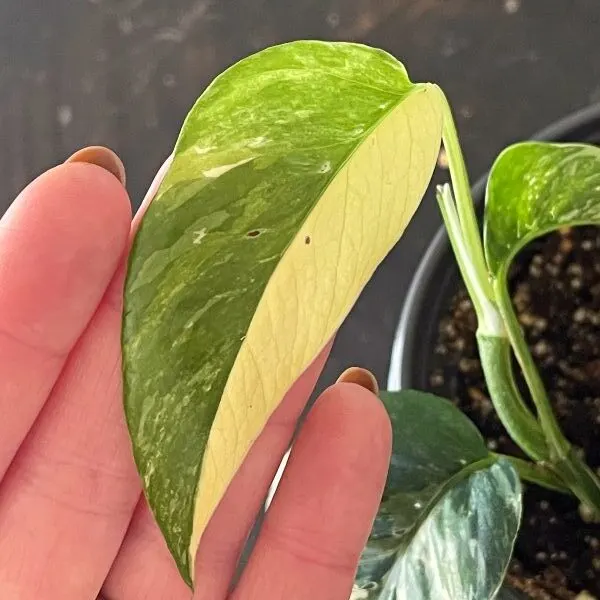
Where To Buy The Epipremnum Pinnatum plant :
There are several Epipremnum Pinnatum types of plants. The Epipremnum Pinnatum albo, Cebu Blue, the Dragons Tail, and Baltic Blue. They are all difficult to source. You may get lucky and run into the Cebu blue in a local shop these days if you get lucky. All of these plants are occasionally sold online at Costa farms. I DID find it in some reputable ETSY shops, linked below.
Is epipremnum pinnatum the same as Cebu Blue? The Cebu blue is one variety of epipremnum pinnatum. But there are more varieties. The Dragons tail and variegated epipremnum pinnatum albo are also sought after varieties of this genus.
As you see pictured below the Cebu blue is a silvery grey green vine with narrow lance shaped leaves. The Dragon tail leaves are shinier, greener and somewhat wider although still pointed.

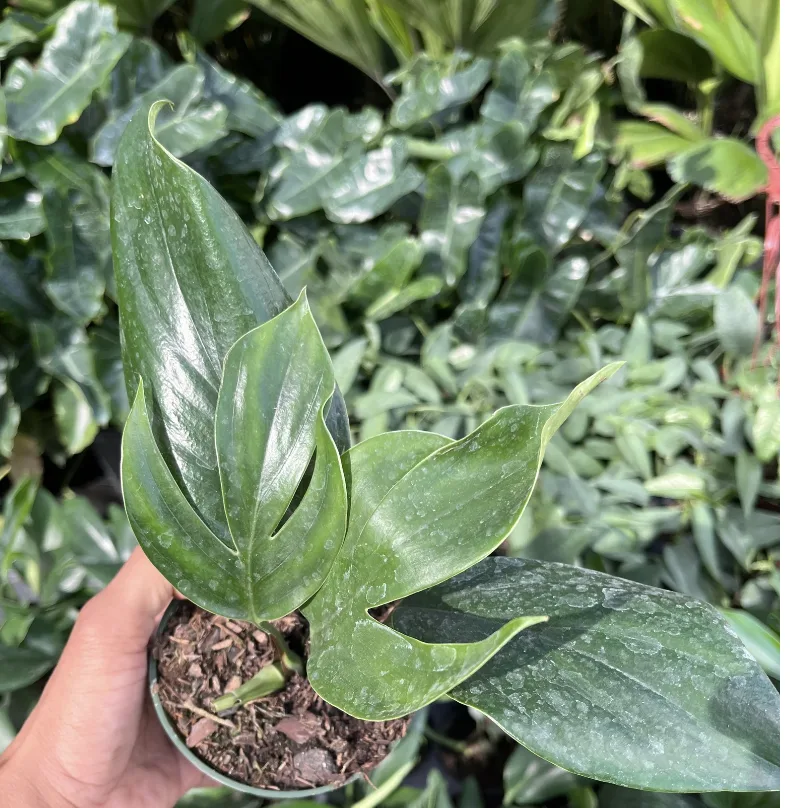
Is Epipremnum Pinnatum Variegata Rare? Epipremnum Pinnatum Albo is quite rare and difficult to source. It is available online at ETSY and sometimes on Costa Farms. The spontaneous unstable sport variegation means this will always be a pricier plant than other pothos since it will not breed true from seed.
This is not a plant you will find in the local plant shop more than likely. The varieties of the Pothos aureum branch of this plant family inhabit almost all the garden shops in one variety of another.
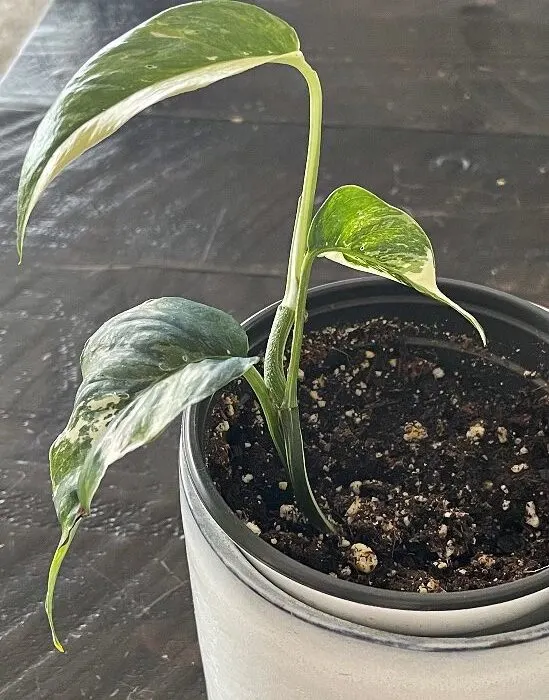
How Does Variegation Work?
Variegation refers to the differently colored sections or patterns on the leaves and stems of this plant. The variegated epipremnum pinnata has a more segmented white or cream coloration running through its leaves. This is a stunning, eye catching variegation.
This plant, like the monstera Albo (no relation) has a spontaneous type of genetic mutation that causes it to display its personal style of variegated patterns. These mutations are unstable and revert back to the original solid-colored form if propagated by seed.
Other factors can also influence the variegation and weather the plant reverts back to the original green color of the Dragon tail parents. These include adequate light to bring out the variety of colors the leaves can produce. Also make sure to keep the plant well fed.
Variegated plants are at a disadvantage since the white or cream parts of the leaves cannot photosynthesize. This means the leaves need brighter light than the green form to feed themselves.
To retain the variegation through propagation, your best chance is to choose a highly variegated stem and leaf for a cutting and do a water or soil propagation. You can see my cutting pictured below has a white stripe running up the side of the stem. This indicates it will produce the white color into the leaves that grow out of it.
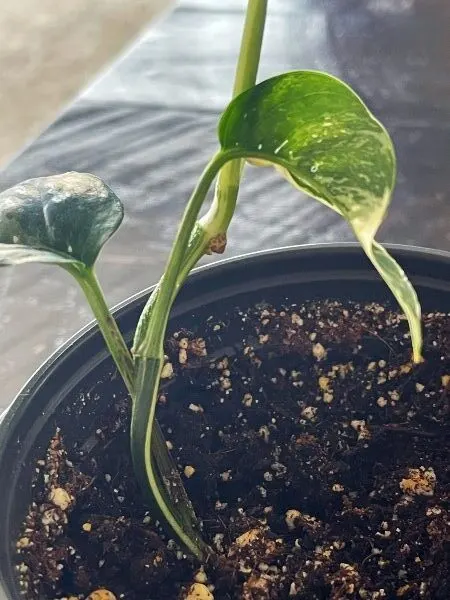
Plants are very beneficial to people emotionally and as an environmental addition to your home.
Read more about why houseplants are beneficial to people here .
The Contented Plant
How do Leaf Fenestrations Grow on this Plant?
My young stem cutting with small leaves has tiny holes in the leaves. As this plant matures it will grow leaves with larger holes or slits. Eventually those slits will completely separate and the leaf will have what are called fenestrations.
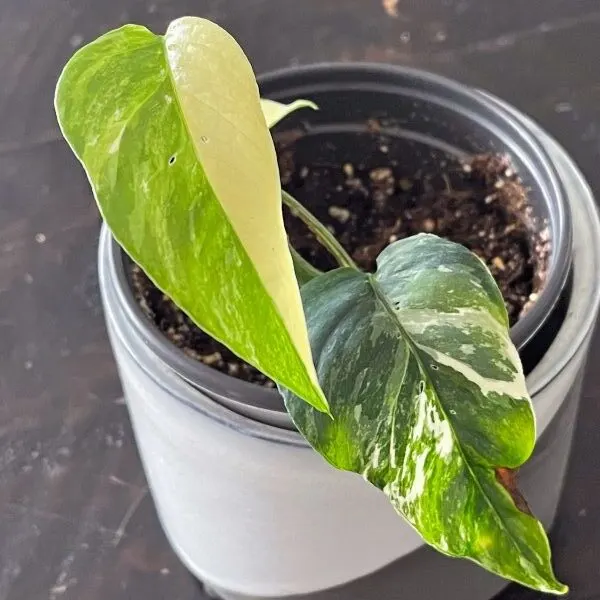
In the comparison pictured below the monstera albo has mature leaf fenstrations fully formed in its leaves. At maturity the my cutting young leaves will grow even larger and those fenestrations will be evenly placed along the leaf.
Because the Epipremnum Pinnatum albo plant is rare, pictures for it as an adult are almost non existent. As mine grows up I’ll update the pics in this post for you so you can see what a lovely plant it turns into.
For now, the monstera albo pictured below is a similar in variegations and the fenestrations. Its STUNNING, but quite a bit larger than my Epipremnum Pinnatum albo will ever get.
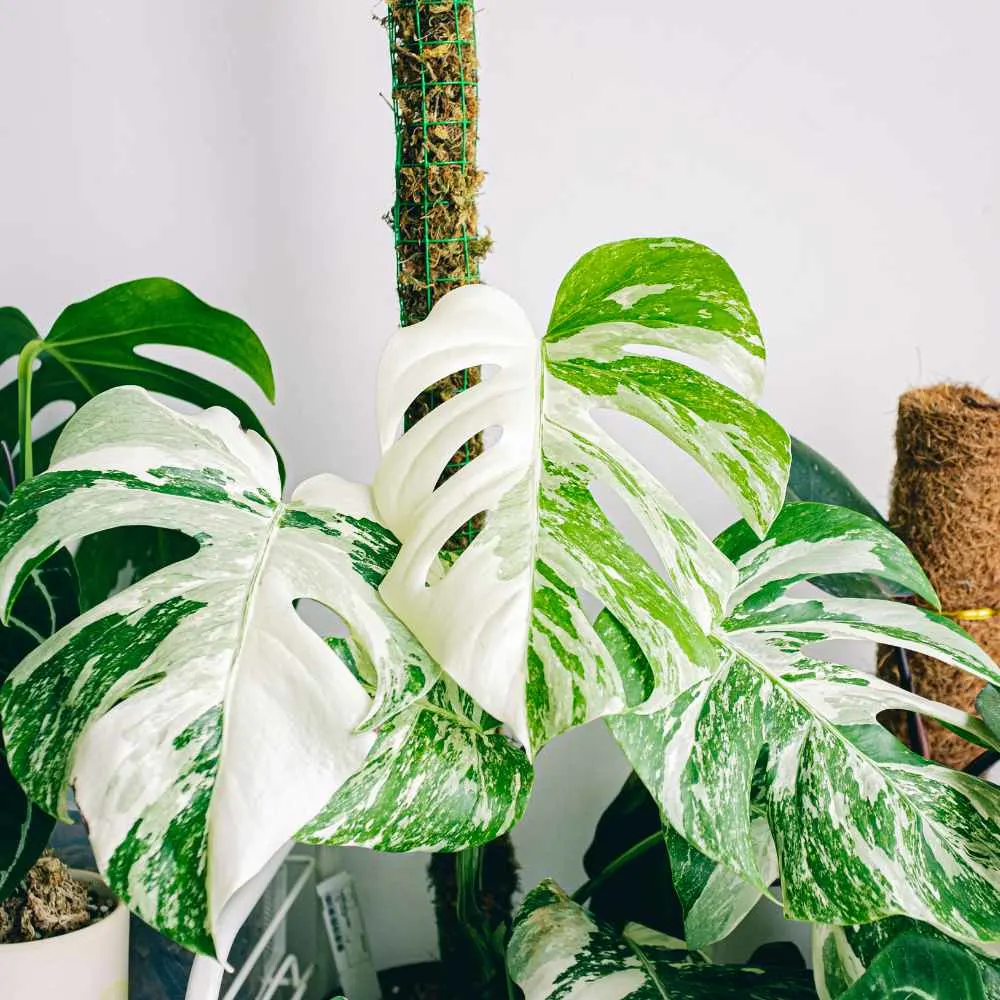
Is Epipremnum pinnatum a monstera? Epipremnum Pinnatum Albo is NOT a relative of the Monstera Albo although when both are all grown up and sitting side by side you will forgiven for thinking they are.
The monstera has larger rounded leaves and is a larger vine all round. The Dragon tail albo looks like the monstera albo’s little sister. 🙂
Caring For Epipremnum Pinnatum plant
Epipremnum Pinnatum plant is a variety of the ‘tough to kill’ pothos plants. Like its relations, this lovely vine will be joy to raise indoors or on a warm patio.
Caring for the sturdy pothos plants can be tricky in one sense. We mostly fuss over these tropical aroid plants too much and kill them with kindness. Overwatering and consequently root rot is a common problem with aroids.
Here are some signs your variegated epipremnum pinnatum is not happy.
- Brown leaves: Read our whole post on why plants get brown leaves and how to fix them.
- Yellowing leaves: Read about yellowing leaves in this post.
- plant pests: We cover 7 of the most common plant pests in this post, identify the pest, learn the damage they do to the plant and how to manage pest infestations.
- Is your epipremnum pinnatum Drooping? Drooping leaves Can mean Root Rot: When we love our plants too much and over water them the roots get sick and die. Then they rot and cannot support the plant. See how to fix that in this article.
Read Through our whole section on Plant Problems and Helps Here!
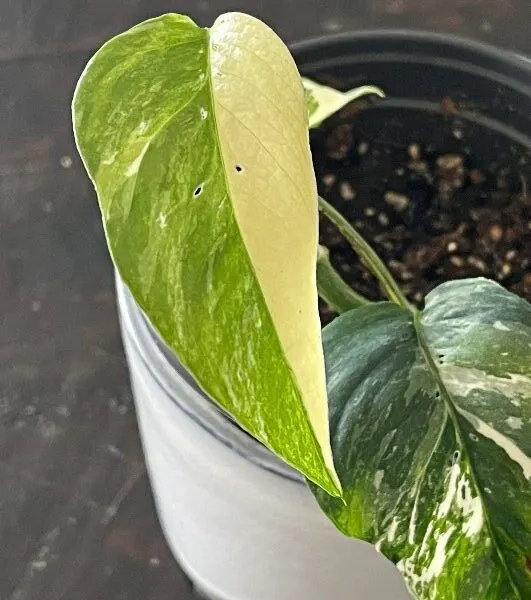
Location, location location! Where to Place This Plant in Your Home
Placing the variegated epipremnum pinnatum correctly in your home will give the plant a great start on showing off it variegation and giving you excellent growth and leaf shape as it grows.
Like the other Pothos, Epipremnum Pinnatum Albo plants grow well in these spots.
- This lively variegated Dragons tail variety will thrive in strong indirect light in a well lit north or eastern exposure in your home. Mine is on a plant shelf in front of a LARGE north facing window and side lit by a set of east facing windowed French doors. It likes it there and has grown quite fast with lovely coloring.
- These plants LOVE humidity. Well lit Kitchens and bathrooms are great locations for this albo.
- Find a spot for it to grow vertically up a pole. This growing method offers the best results for leaf size and fenestrations.
- In the warm months of the year this plant can be placed outdoors on a patio with INDIRECT light. Strong sunlight will burn the leaves. You may need to transition it slowly if you have harsh strong natural sunlight nearby. Outdoor sun (even indirect natural sunlight) is more intense than even a brightly lit room in your home.
Epipremnum Pinnatum Variegata Care Guide:

With the right care, your Epipremnum Pinnatum plant will thrive and bring a touch of beauty to your home. Just make sure to keep an eye on the plant and provide it with the right environment, water, and nutrients to ensure that it stays healthy and happy.
Here’s a summary of all you need to know to grow this plant and keep it happy. We also include our printable care guide below this table.
| Familiar Names: | Devils Ivy, Centipede tongavine and dragon-tail plant. In the Philippines its locally known as tibatib. |
| Scientific Name: | Epipremnum Pinnatum |
| Plant Family: | Araceae family |
| Care Difficulty: | Easy |
| Temperature: | Epipremnum Pinnatum variegata plants like to be kept in warm temperatures, so make sure they are not placed in a location that is too cold. The ideal temperature range is between 65 and 85 degrees Fahrenheit. If growing outdoors on a patio bring it indoors when temperatures outdoors drop to 65 at night. |
| Watering: | Watering Epipremnum Pinnatum plants are fairly drought-tolerant, so they don’t need to be watered very often. During the summer months, you should water the plant once per week, and during the winter months, you should water it once every two weeks. When you do water the plant, make sure that you use lukewarm water and keep the soil evenly moist, but not soggy. Self watering plant pots are good choices for these vines. |
| Humidity: | epipremnum pinnatum variegata enjoys humidity. If the air in your home is too dry, less than 45% humidity, you can increase the humidity around the plant by misting the leaves with lukewarm water once or twice a day. You can also group plants near each other so they respire moisture into the air and benefit each other. Pebble trays near the plant and filled with water help increase the air humidity. Or place a humidifier nearby. |
| Fertilizer: | Epipremnum Pinnatum plants also need regular fertilizing to stay healthy. During the growing season (spring and summer), you should feed the plant once a month with a balanced liquid fertilizer. During the winter months, you should cut back on fertilizing and only feed the plant once every two months |
| Soil: | Epipremnum Pinnatum plants prefer to grow in a soil that is well-draining and has a slightly acidic pH. A commercial potting mix designed for houseplants works well, or you can make your own by mixing together equal parts peat moss, perlite, and vermiculite. |
| Lighting | Epipremnum pinnatum variegated thrive in bright, indirect sunlight. While they can tolerate a few hours of direct sun each day, they will not do well if they are placed in a location with full sun exposure. The variegations will fade and the leaves can revert to solid green in low light. Once the variegations are lost they may never come back. |
| Growth | epipremnum pinnatum albo is a vine that loves to grow up things. It can be trained up a moss pole, shelf or other structures. You can let it drape its vines over the edge of tables, shelves or stairwells. it will grow as hanging vines, but an upright climbing habit encourages better leaf size and fenestrations. |
| Pruning: | Epipremnum Pinnatum plants can grow quite large, so it’s important to trim them back periodically to keep them looking tidy. Trim off any dead or yellowing leaves, as well as any long, straggly stems. You can also use pruning to encourage new growth and shape the plant. Prune with sharp hand pruners so you don’t injure the vine. |
| Pests: | Variegated Epipremnum Pinnatum plants can be prone to pests like mealybugs and spider mites. If you notice any signs of pests, such as discolored leaves or sticky residue on the leaves, you should treat the plant with an insecticidal soap. |
Epipremnum Pinnatum Albo vine

All Pothos have only a few basic requirements to remain a happy durable plant.
This lovely Epipremnum Pinnatum Albo vine is a perfect beginner houseplant.
Materials
Instructions
Pothos Soil Preference:
- This aroid requires a light soil.
- A mix of potting soil and perlite will keep the roots happiest.
- Our mix for this pothos is 40 % potting mix to 60% perlite.
- A heavy soil potting mix is not recommended for aroids.
Pot Size and Type:
- Pothos vines can be grown in relatively small pots since they are fairly slow growers.
- If you want to encourage faster growth choose a pot about 2 inches wider in diameter than the current pot.
- Any well drained pot can be used. It MUST have drainage.
- Repot every second year or when roots come out the drainage holes on the pot bottom To the next pot size up.
- Don't jump to a huge pot from a small one unless you wish to encourage faster growth. Just go to the next size up pot.
Pothos Lighting Requirenments:
- The pothos vines enjoy moderate to bright indirect or dappled light. Hover, It will tolerate lower indirect light it if has some brighter moments in the day.
- The variegated types of pothos require more light to show off their colors best.
- Shield this aroid from strong direct light in summer south and west sunny windows. The leaves will burn.
- Tip: Window sheers or blinds can offset some brief periods of high direct light.
How to Water a Pothos:
- Water your Epipremnum Aureum when the soil is dry down an inch or so. Give it a good soak so all the soil is moist. Then let the pot completely drain. Pour out any water in the drain plate.
- Aroids do not like to be overly wet. Try a watering schedule of every other week. But let the plant guide you rather than the calandar.
- This tropical plant enjoys humidity. In dry climates this Pothos will thrive with a humidifier nearby. or set it in your kitchen or bathroom. For a really dry climate frequent misting will help.
- In dormant winter months reduce watering to when the soil is dry down halfway .
- Never let this plant get wet feet. If the soil is compacted the bottom of the soil can remain wet which encourages root rot and fungus gnats. If you see yellow leaves on pothos you are probably overwatering.
How to Fertilize a Pothos:
- Apply a good quality fertilizer (linked in materials) monthly through Spring and summer.
- Decrease feedings by late Fall and allow the pothos to rest through the winter months.
- Look for brown spots on the leaves of your plants. This may indicate an over concentration of salts in the roots from over feeding. It can burn the leaves.
- Read Our Post On Fertilizing plants for more information.
Temperature:
- Keep pothos at a low of 65 Degrees F. to upward of 85 Degrees F. It enjoys warmth and humidity.
Pruning and Training:
- Pruning will give you a fuller plant with more even growth. Unpruned pothos will trail.
- Sharp Hand pruners are preferred for pruning. They will give a clean cut that will heal quickly.
- Train your Epipremnum Pinnatum to grow up a spahgmum moss pole for best growth, fenestrated leaves and leaf size. Thye love to grow up!
Table Top Plants:
- It’s easy to prune and shape these plants to whatever length and fullness you desire.
- As a table top plant cut the trailers back evenly all around the pot. If you want the pot fuller add more starts of the neon.
Pests:
- Pothos is not fussy and resists pests. However all plants can get attacked by pests.
- Stress by longterm overwatering, poor light, extreme temperatures and soil conditions are contributors to plant stress..
- Read Our Post on 7 most common plant pests and how to kill them.mites, mealy bugs, spider mites, scale, thrips and whitefly are the most common houseplant pests you will see.
- Read our post on How to get rid of aphids and other pests with our homemade pesticide soap recipe or neems oil.
- To minimize the possibility of pests be sure to check all nursery plants before bringing them home.
- Quarantine all new plants until you are sure no pests live in them.
How to Propagate:
- Propagation is easily done through leaf node stem cuttings.
- You need a 3 to 6 inch leaf stem with a couple of nodes and healthy growth.
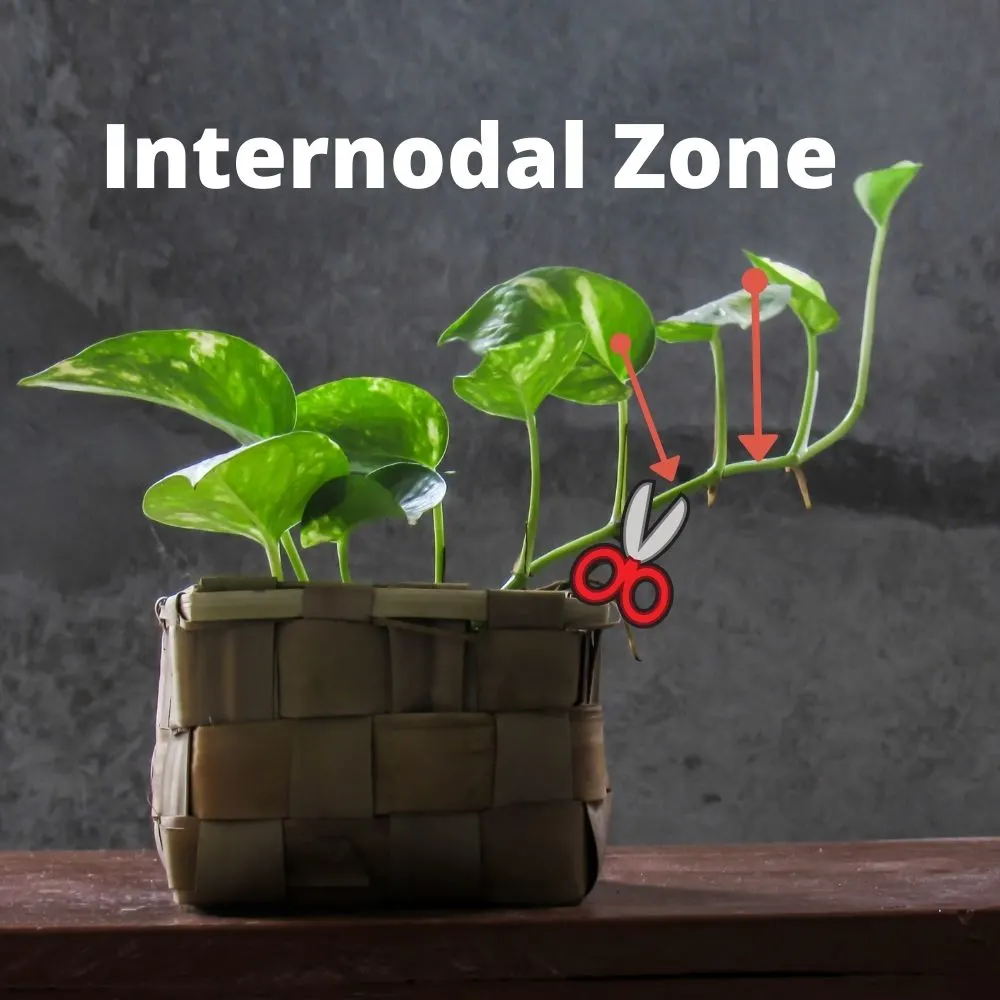
- Place the node into a jar with water. Use tap water that has settled 24 hours in the jar to dissipate chemicals harmful to the neon.
- Set the jar in a well lit area.
- After several weeks roots will grow. Allow the roots to get an inch or more in length.
- Plant gently and firmly into pot with proper soil mix.
- Make sure to keep the soil moist until the roots begin to set into the soil. Be sure to read our post on Propagaing pothos here.
Notes
watch our video below for more on pothos care and propagation.
Epipremnum Pinnatum plants are Toxic:
All the pothos or devil’s ivy, including this variety, are toxic to pets if ingested. So it is important to keep this plant away from cats and dogs that enjoy chewing plants. Symptoms of ingestion in pets may include vomiting, lethargy, and difficulty walking. If you suspect that your pet has ingested any part of an Epipremnum pinnatum plant, it is important to contact your veterinarian immediately.
These plants contains insoluble calcium oxalates. Even in humans this can cause irritation and swelling of the mouth and throat, difficulty swallowing, and vomiting if ingested. While the plant is not lethally toxic to humans, it is important to keep it away from curious young children.
The sap may cause skin irritation in some people. If you experience any irritation or other adverse reactions after handling the plant, it is recommended that you wash your hands thoroughly and avoid further contact with the plant unless you wear gloves.
More Pothos Plants to Love:
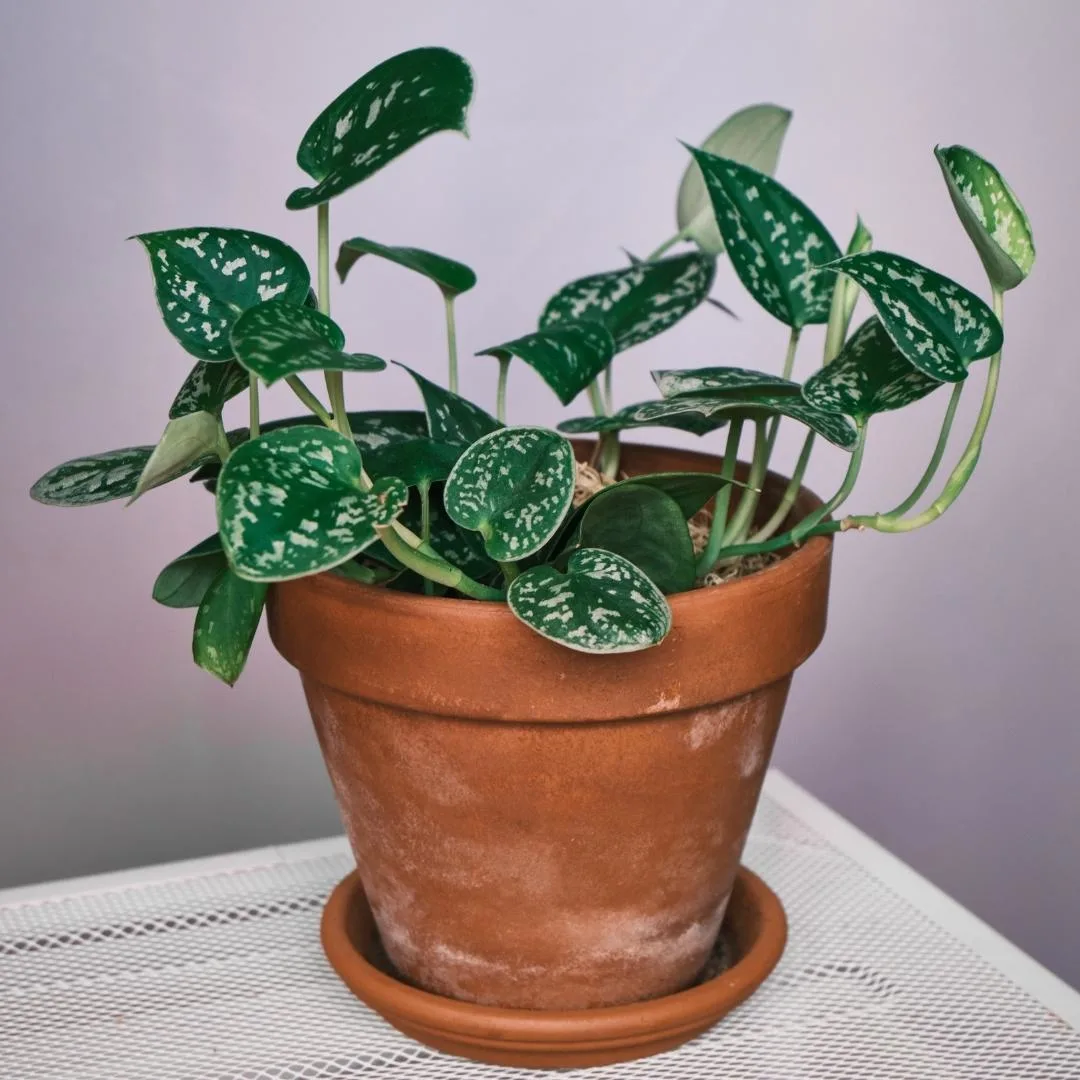
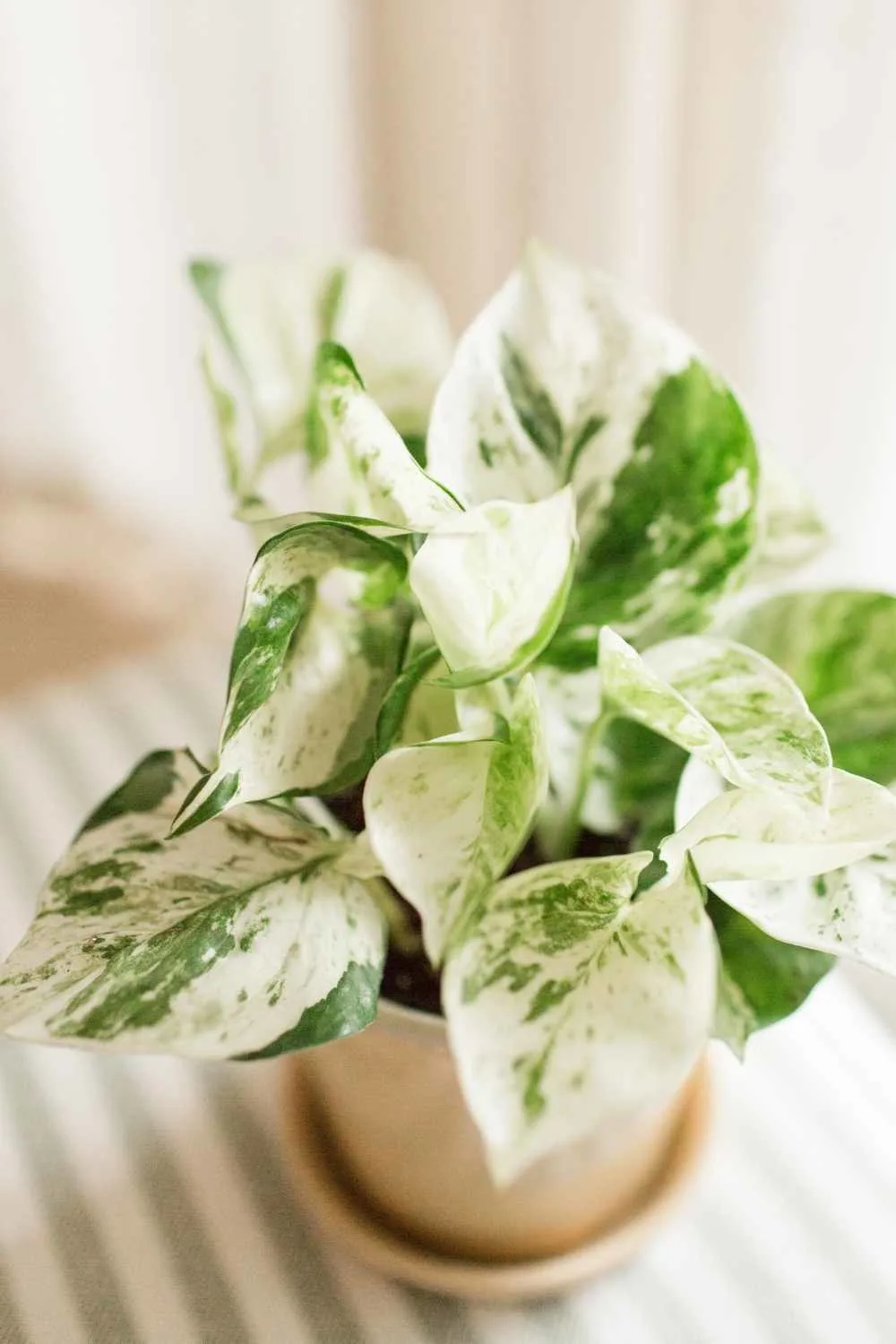
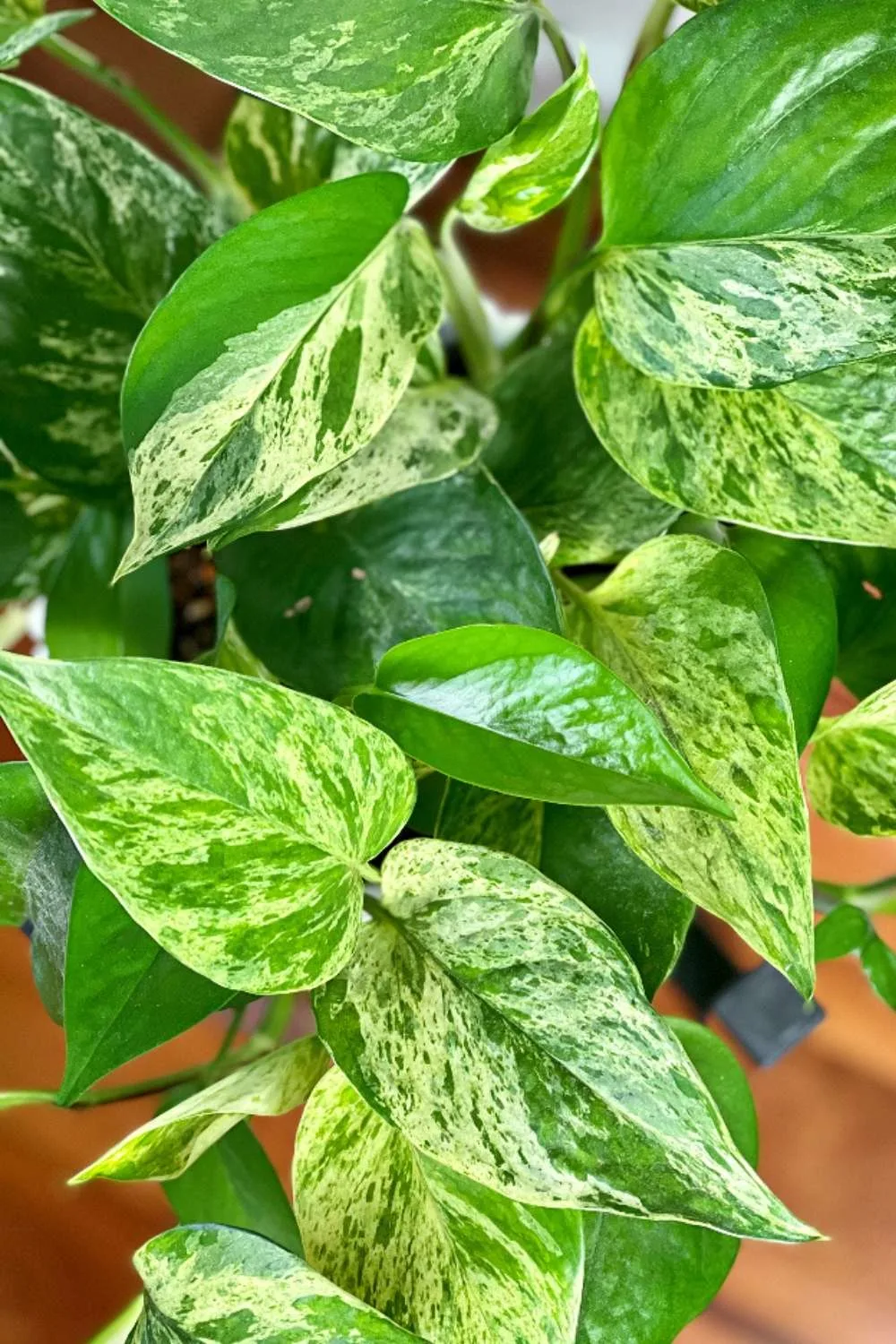
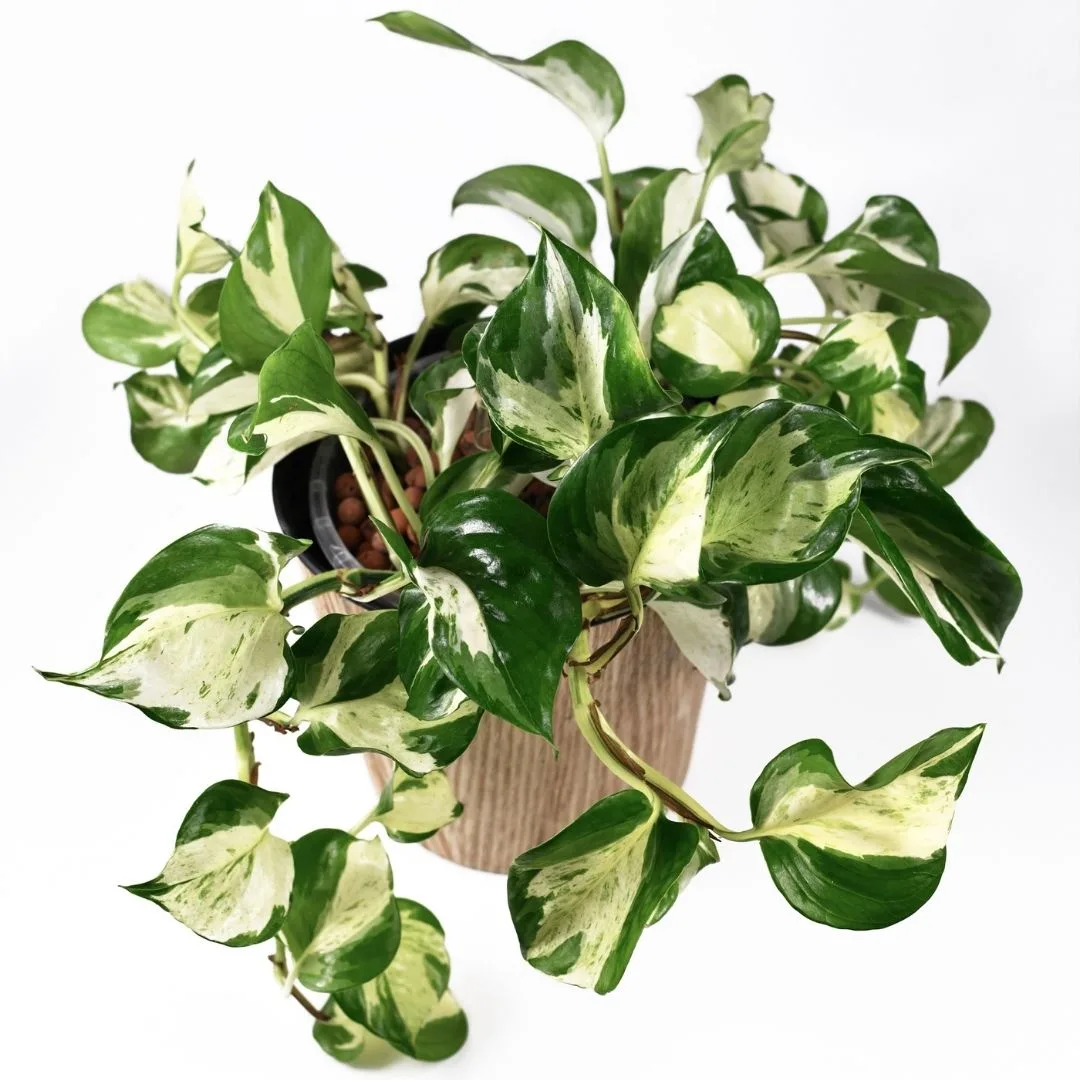
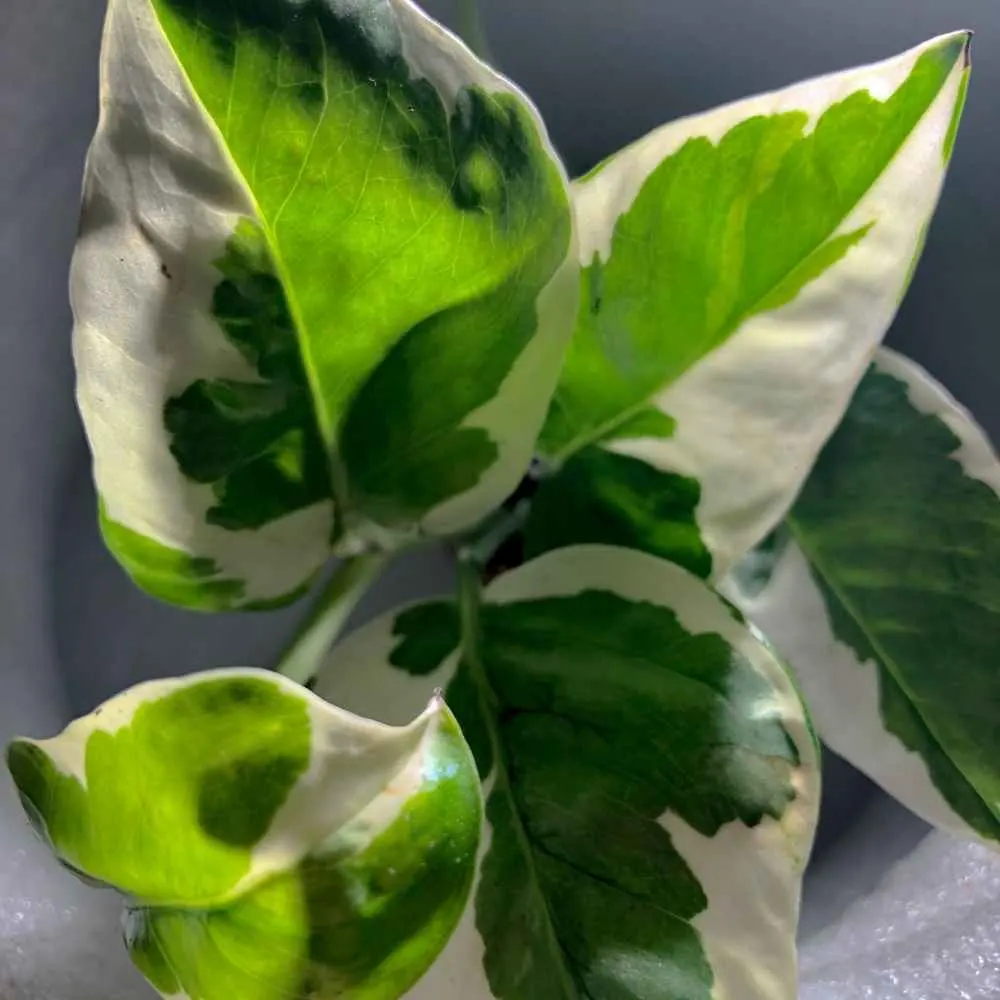
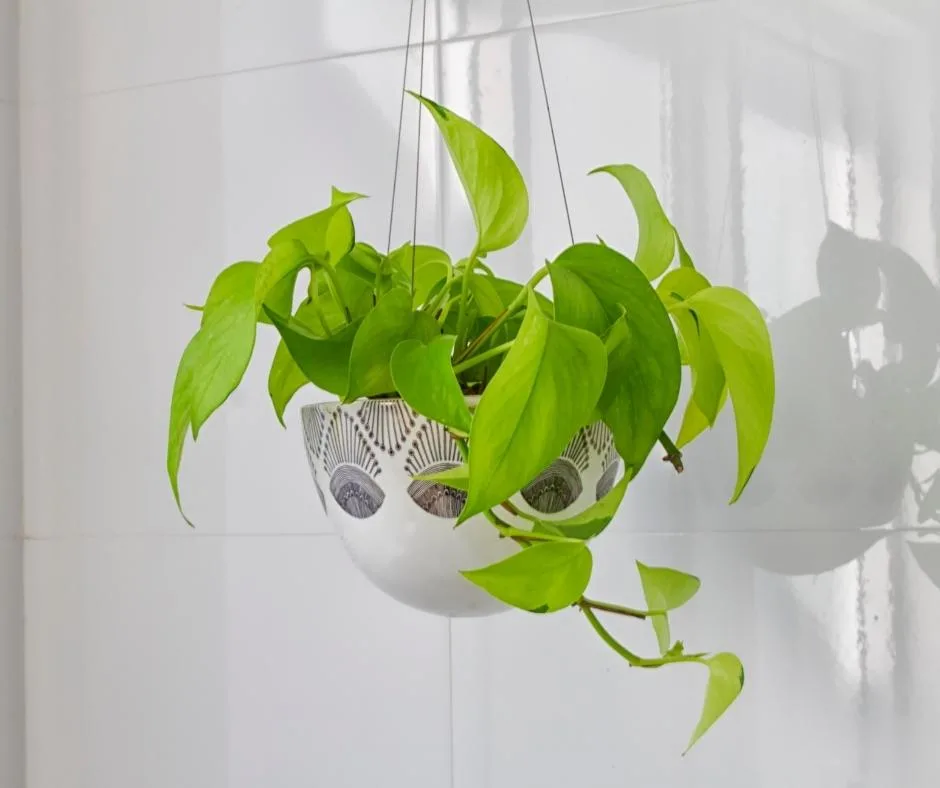
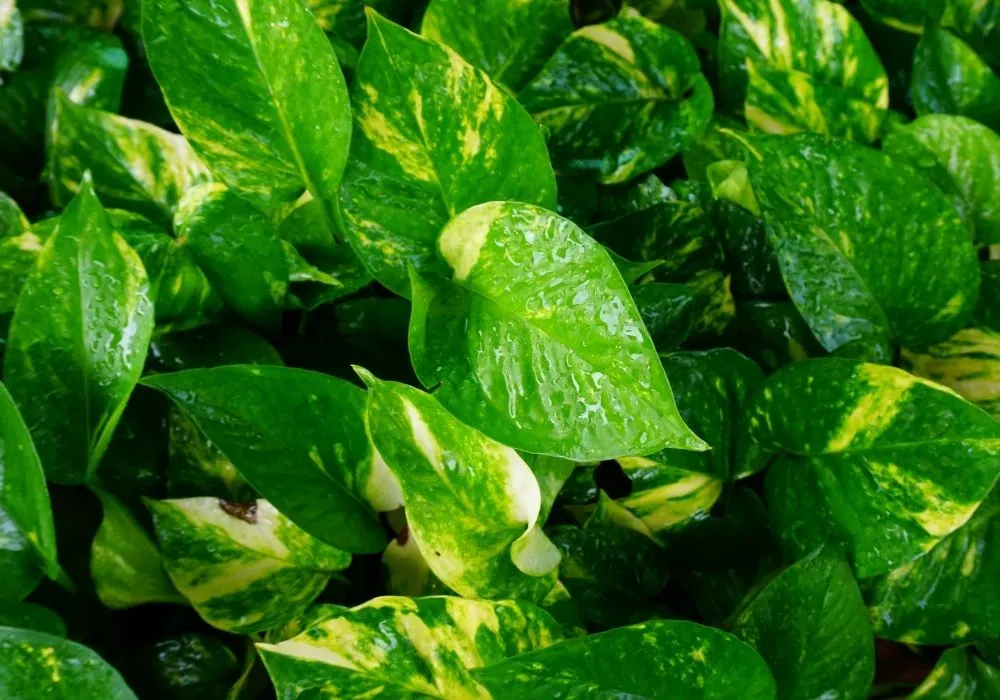
Follow Us:
Find us on YouTube, Instagram , Pinterest and TikTok! We love to Plant chat. We also comment, like and occasionally share your content to our daily stories. We’d love to see your plants. Share your joy in your houseplants. Happy Planting!
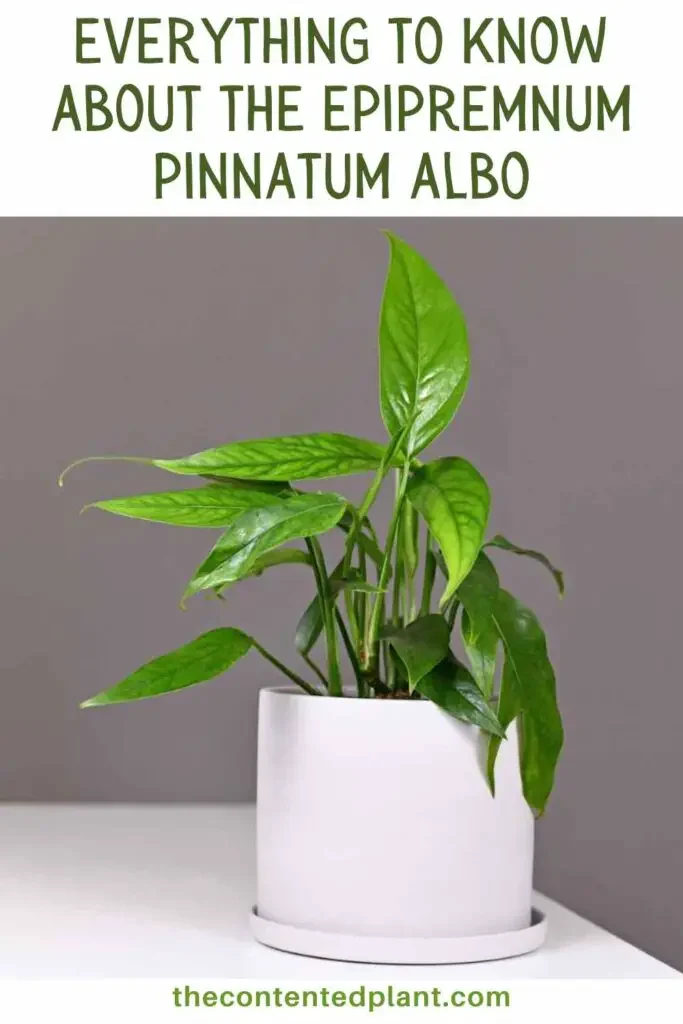

Epipremnum Pinnatum: Dragons Tail - The Contented Plant
Saturday 6th of January 2024
[…] variegated form of Epipremnum pinnatum is known as Epipremnum pinnatum albo-variegata it has white variegations on its lovely dark green leaves. Read our post on Pothos, different […]